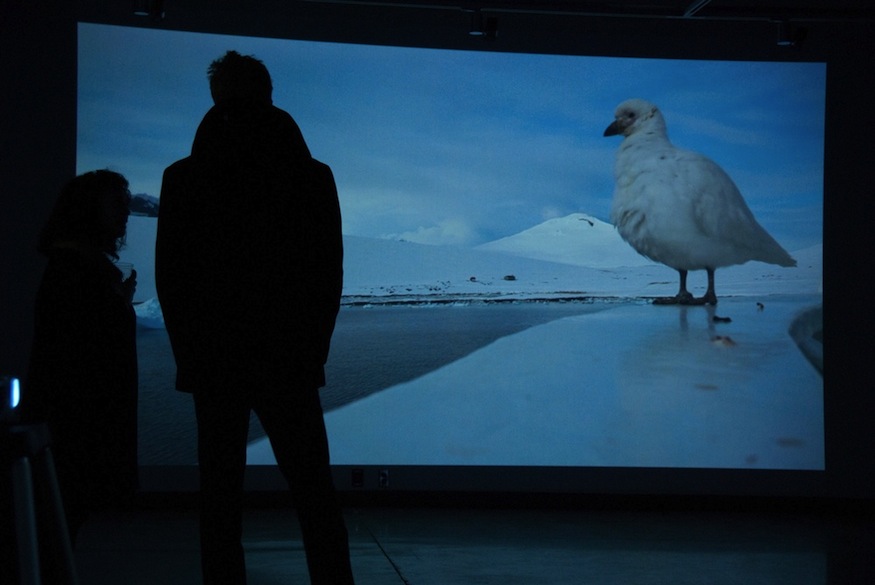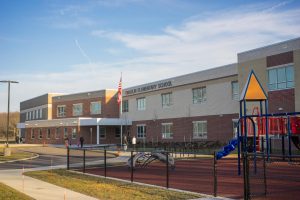Video Installation Desert Blue Gives Audience Chills
As a prize for winning the 2008 National Geographic Traveler World in Focus photography contest, Associate Professor of English and Cinema Studies Program Director Geoff Pingree and Associate Professor of Cinema Studies/New Media Rian Brown-Orso got to take a trip to Antarctica aboard the National Geographic cruise ship Endeavor. This past weekend, Blue Desert: Towards Antarctica, the video installation resulting from their trip, was on display in the Baron Gallery.
February 24, 2012
Antarctica is on average the coldest, driest and windiest continent on Earth, with temperatures reaching -89 °C (-129 °F). Polar deserts, relatively common during ice ages, still make up most of the land’s interior, despite its thick ice cover. But none of this stopped Associate Professor of English and Cinema Studies Program Director Geoff Pingree and Associate Professor of Cinema Studies / New Media Rian Brown-Orso from embarking on a three-week expedition to Earth’s southernmost continent to collect footage for their installation Blue Desert: Towards Antarctica, on display at the Baron Gallery Thursday, Feb. 16 to Saturday, Feb. 18.
Pingree’s journey to the South Pole, however, began in a location quite opposite both in terms of population and climate — Madrid, Spain. Late in the summer of 2005, a friend of Pingree’s was writing a story on an exhibition at the Prado Museum in Madrid and invited him along to shoot photographs. The exhibition, titled The Palace of the Planet King was one of unique proportions, showing not only master works by Spanish artists, but also incorporating related staged theatrical scenes. The performances were intended to remind visitors of Philip IV’s great patronage of the arts by recreating a sense of the Hall of Realms — the original home to some of Velázquez’s most famous works — in what was Philip IV’s pleasure palace, the Buen Retiro.
One particular scene that Pingree photographed is of actors playing King Philip IV, his second wife, Mariana de Austria, and the Golden Age playwright Calderón de la Barca, strolling through one of the Prado’s halls and stopping in front of Velázquez’s “The Surrender of Breda” to gaze at the painting while the museum–goers behind them stand by in awe at the spectacle. This photograph, “Behold,” went on to win the grand prize in National Geographic Traveler magazine’s 2008 World in Focus photography contest — a 15 day trip for two to Antarctica aboard National Geographic’s cruise ship Endeavour.
Aboard the ship, Pingree and Brown-Orso shot hours of footage with extremely high-resolution cameras and sound equipment. Avoiding the contemporary cinematographic grammar of the mobile camera, the two instead anchored the camera in stationary frames. Any and all movement of the shot is attributed to the camera being on or in front of the ship, rocking back and forth with the current.
The setting is Antarctica, a sublime world that is at once unfathomable and profound, beautiful and alien. The two filmmakers’ exhibitions put forth a rendering through an interaction between contrasts — between light, shadow, color, form, movement and space. Projected onto six gallery walls, the video installation presented separate films showing simultaneously; the resulting sensation is that of being on the ship. We do not see any of the passengers, however, which further highlights the isolated nature of the location, as we are placed in a vulnerable, almost overwhelming viewpoint.
Further simulating the sensation of this world, Blue Desert features sound designed by Assistant Professor of Computer Music and Digital Arts Peter Swendsen. His unique composition that accompanies the installation filled Baron Gallery with ambient music that was both tranquil and unsettling, much like the footage, and additionally contributed to the viewer’s movement through the exhibition. The audience moved throughout the gallery’s two rooms slowly and quietly, mimetic of the appearance of the Antarctic landscape.
Due to the two room layout of the gallery, Blue Desert was forced to adjust the structure of the exhibition, which was initially intended to take place within a four-walled enclosure. The filmmakers had offered two separate models for how the installation could take shape as described on the filmmakers’ website. The first being “four separate video channels rear-projected, from within, onto the four walls of a large cube positioned in the middle of the room. The cube, made of rear-screen projection material stretched onto a frame, will be illuminated by four projectors integrated with a video mixer and computer and will be accompanied by an independent audio score emanating from a strategic configuration of surround sound speakers. In this version, spectators will be able to circle the entirety of the cube.” The second stated, “This version will consist of four separate video channels front-projected onto a gallery’s four walls, again using four projectors integrated with a video mixer and computer and surround sound speakers. In this version, spectators will be encircled by image and sound.”
The composition nevertheless still met the initial expectations of engulfing the viewer in the world of the footage by surrounding them by motion pictures upon entering the room. The exhibition was powerfully moving and most likely came as close as possible to capturing this sublime world, as Pingree and Brown-Orso set forth to do.
The life changing expedition does not end here in Baron Gallery, however. Pingree and Brown-Orso have intentions for the project to become a feature-length film to be released in theaters, hopefully later this year.


















